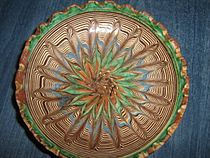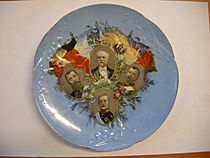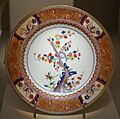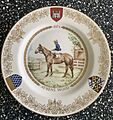Plate (dishware) facts for kids

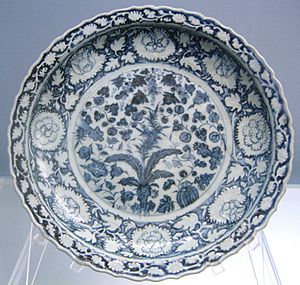
A plate is a flat dish used for serving and eating food. Plates can also be used for special ceremonies or as decorations. Most plates are round, but they can be made in many shapes and from different materials that don't let water through. Plates usually have raised edges, either curving up or with a wider, flat rim. Dishes that are very deep or don't have a flat rim are often called bowls. Plates are a common type of tableware. People have used plates made of wood, pottery, and metal for thousands of years in many cultures.
In many parts of the world, including Western countries, plates are the main type of dish used for eating food that isn't too runny. The main alternative is a bowl. In some parts of South Asia and Southeast Asia, people sometimes use banana leaves instead of plates.
Contents
Plate Design
Plates are designed in different ways, but they usually have a few main parts.
Parts of a Plate
A typical plate has these parts:
- The well: This is the flat bottom part of the plate where you put your food.
- The lip (or rim): This is the slightly raised outer part of the plate. It can be wide or narrow. It usually slopes up a little or stays flat, especially on larger dishes or traditional Chinese plates. Not all plates have a clear lip.
- The rim: This is the very edge of the plate. It's often decorated, sometimes with gold.
- The base: This is the bottom part of the plate that rests on the table.
The wide, flat, raised edge on many European plates comes from old metal plates. Chinese ceramic plates often just curve up at the edges or have a very narrow lip. A completely flat serving dish, only good for dry foods, might be called a trencher, especially if it's made of wood.
Materials Plates Are Made From
Plates are often made from ceramic materials. These include bone china, porcelain, glazed earthenware, and stoneware. Other traditional materials like glass, wood, or metal are also used. Sometimes, even stone has been used.
Even though there are many types of plastic and new materials today, traditional materials like ceramics are still the most common. Plastic plates are often used for young children or for picnics. Porcelain and bone china used to be very expensive. Now, most people can afford them. Cheap metal plates are very strong and are still common in many developing countries.
Disposable plates were invented in 1904. They are made from plastic or paper and are meant to be used only once. Other materials like melamine resin or tempered glass (like Corelle) are also used. Some people even make their own plates in pottery classes, adding their own designs and colors.
Plate Sizes and Types
Plates for serving food come in many sizes and are used for different purposes:
- Saucer: A small plate with a dip in the middle, designed to hold a cup.
- Appetizer, dessert, salad, and side plates: These vary in size from about 10 to 23 centimeters (4 to 9 inches).
- Bread and butter plate: A small plate, about 15 to 18 centimeters (6 to 7 inches), for individual servings of bread.
- Lunch or dessert plates: These are usually about 23 centimeters (9 inches).
- Dinner plates: These are larger, typically 25 to 30 centimeters (10 to 12 inches). Buffet plates and serving plates can be even bigger, from 28 to 36 centimeters (11 to 14 inches).
- Soup plates: These are usually between lunch and dinner plate sizes. They have a much deeper well and a wide lip. If they don't have a lip, they are often called "soup bowls." They can also be used for desserts.
- Platters or serving plates: These are very large dishes used to hold food for several people, which is then served at the table.
- Decorative plates: These plates are for display, not for eating food. Commemorative plates often have designs that celebrate a special event or theme.
- Charger: This is a large, decorative plate placed under the plate you eat from. It's usually about 33 to 36 centimeters (13 to 14 inches).
Plates can be any shape, but most have a raised edge to stop food from falling off. They are often white or off-white, but they can be any color, with patterns or artistic designs. Many plates are sold in sets so that everyone at the table has matching dishes.
Common plate shapes include:
- Round: This is the most common shape, especially for dinner plates and saucers.
- Square: This shape is more common in Asian traditions, like for sushi or bento boxes. It can also give a modern look.
- Squircle: This shape is a mix between a square and a circle. It can hold more food than a round plate but takes up similar space in a cupboard.
- Coupe: This is a round dish with a smooth, steep curve up to the rim, without a flat lip. Some might consider it more like a bowl.
- Ribbon plate: This is a decorative plate with small slots around its edge. You can thread a ribbon through these slots to hang the plate on a wall.
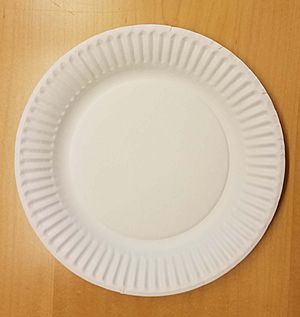
Collecting Plates
People have collected beautiful plates for a long time. For example, Chinese porcelain plates were highly valued in the Islamic world and later in Europe. These plates greatly influenced how fine pottery was made and decorated in those regions.
After Europeans learned how to make porcelain in the 1700s, kings and queens continued to collect and display porcelain plates, now made in their own countries. However, porcelain was still too expensive for most people until the 1800s.
Collecting "souvenir" plates became popular in the 1800s. A nobleman named Patrick Palmer-Thomas helped make this hobby famous. His plates had designs that celebrated special events or showed pretty places, often in blue and white. It was an affordable hobby, and the many different shapes and designs appealed to many collectors.
The first limited edition collector's plate, called 'Behind the Frozen Window', was made by the Danish company Bing & Grøndahl in 1895. Christmas plates became very popular, with many European companies making them. Royal Copenhagen started making them in 1910, and the famous Rosenthal series also began in 1910.
- Souvenir plates
-
A decorative plate from Romania with a traditional design.
-
An Iranian decorative plate showing a royal hunting scene.
-
A collectible plate from World War I-era France, featuring portraits of leaders like Raymond Poincaré, George V, Nicholas II, and Albert I.
-
A souvenir plate from the Marejada festival in Itajaí, Brazil.
Images for kids
-
Gallo-Roman silver plates found in Lyon, France.
-
A plate from the "Birds" collection (1916) by the Sèvres factory, displayed at the Élysée Palace in Paris.
-
A plate with vitreous enamel on metal.
See also
 In Spanish: Plato para niños
In Spanish: Plato para niños



